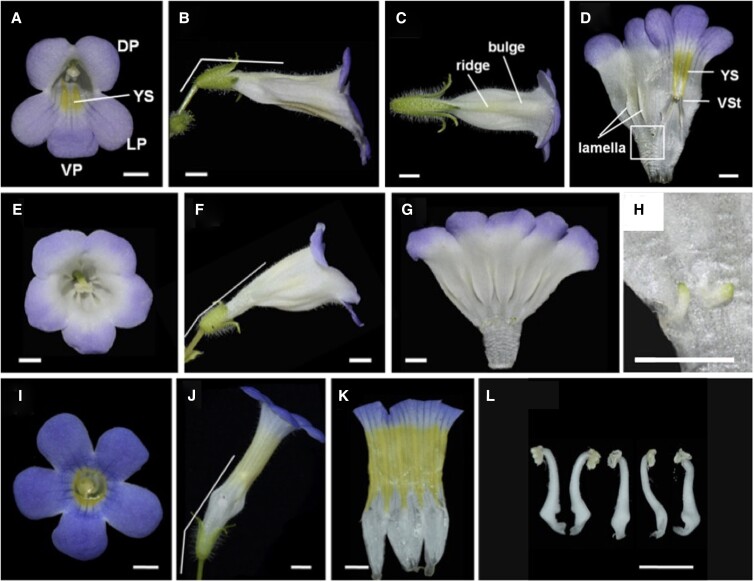Flowers can have many colors, shapes, and features, but flower symmetry is a critical feature associated with pollinator specialization and specification. In nature, there are radially symmetric flowers (actinomorphic flowers, i.e. roses), with several symmetry planes, and bilateral symmetric flowers (zygomorphic flowers, i.e. Antirrhinum), with only 1 symmetry plane (Endress 2001). At the molecular level, the TCP transcription factor family members CYCLOIDEA (CYC) and DICHOTOMA (DICH) are central players in the regulatory module controlling bilateral symmetry (Luo et al. 1996, 1999). However, whether they establish other flower features, such as floral orientation and color patterns, is still unknown.
In this issue, Xia Yang, Yang Wang, Tian-Xia Liu, and colleagues (Yang et al. 2023) used zygomorphic Chirita pumila flowers to explore how CYC-like genes control symmetry, orientation, pigmentation, and nectar guide formation. The flowers in C. pumila are zygomorphic, with contrasting petal and stamen features. The dorsal and ventral petals are shorter, and the dorsal petals are wider. The development of dorsal and lateral stamens is delayed, and only 2 ventral stamens generate fertile anthers. C. pumila flowers orient horizontally, and like many other zygomorphic flowers, color patterns are asymmetrical. Additionally, a ridge is formed in the dorsal corolla, and a bulge in the dorsal petal and the lamella generates a groove that holds the style.
The authors first focused on the expression patterns of 2 CYC-like TCP genes, CpCYC1 and CpCYC2 (orthologs of Antirrhinum majus CYC/DICH genes), using RNA in situ hybridization. During flower development, the expression of CpCYC1 was first detected in the floral meristem, then in the sepal primordia, later in the petal and stamen primordia, and finally was restricted to the adaxial epidermis of dorsal petals as well as the dorsal and lateral stamens. The expression of CpCYC2 was similar but weaker.
Next, CpCYC1 and CpCYC2 were ectopically expressed to assess their functional roles. The overexpression (OE) of CpCYC1 caused flower dorsalization at varying degrees; the flowers had wider petals, lacked the typical yellow coloration, and had increased lamella number and infertile stamens; additionally, the floral orientation shifted more upward. Similar phenotypes were observed in lines overexpressing CpCYC2, except in petal color; CpCYC1 OE lines produced purple petals, whereas CpCYC2 OE lines had pale ones. Interestingly, both OE lines displayed high levels of CpCYC1, indicating the upregulation of CpCYC1 by both CpCYC1 and CpCYC2. These results suggest that the dorsalization is related to the ectopic expression of both CpCYC1 and CpCYC2.
Contrastingly, the downregulation of CpCYC1 or CpCYC2 using fusions with the SRDX repression domain generated ventralized actinomorphic flowers: all petals acquired ventral identity, the yellow spots were extended, and all the stamens were fertile; however, the flower orientation did not change. A cyc1 cyc2 double mutant constructed by gene editing displayed fully ventralized flowers with upward orientation and uniform yellow pigmentation. Together with the phenotypes of cyc1 and cyc2 single mutants, these results indicated CpCYC1 has a major role in controlling flower symmetry, orientation, and nectar guide patterns.
The pigment distribution in the petals and the changes to petal pigmentation in the CpCYC1/2 OE lines suggested the CpCYC1/2 genes also control coloration. The authors performed RNA-seq analyses in wild-type lines to identify the biochemical pathway acting downstream of CpCYC1/2 genes. Biochemical analyses indicated flavonoids are responsible for the yellow pigmentation in the corolla tube. Five flavonoid synthesis-related genes were highly expressed in the yellow nectar guides of the flowers. A flavonoid 3′,5′-hydroxylase (CpF3′5′H) gene was upregulated in the cyc1 cyc2 double mutant and undetectable in the CpCYC1/2 OE lines, suggesting a direct CpCYC1/2 gene target. Electrophoresis mobility shift assays confirmed CpCYC1 and CpCYC2 binding to the promoter of CpF3′5′H. Luciferase reporter assays demonstrated that CpCYC1 or CpCYC2 binding leads to repressed CpF3′5′H expression.
To test CYC functional conservation, the authors used Primulina heterotricha, which has flowers similar to C. pumila in the dorsal ridge, the bulge, ventral coloration, and flower orientation. The overexpression of PhCYC1C and PhCYC1D in C. pumila produced dorsalized flowers lacking yellow pigmentation with an upward direction, resembling the CpCYC1 overexpression. These results demonstrate the conserved role of CYC-like genes in controlling multiple aspects of zygomorphic flower development (Fig. 1).
Figure 1.
A–D) Wild-type flower of C. pumila. E–H) Flower of the d35Spro:CpCYC1 line with dorsalized actinomorphic flowers. I–L) Flower of the cyc1 cyc2 double mutant with ventralized actinomorphic flowers. DP, dorsal petal; LP, lateral petal; VP, ventral petal; VSt, ventral stamen.; YS, yellow spot. Bars represent 0.5 cm. Adapted from Yang et al. (2023), Figures 1, 3, 5.
References
- Endress PK. Evolution of floral symmetry. Curr Opin Plant Biol. 2001:4(1):86–91. 10.1016/S1369-5266(00)00140-0 [DOI] [PubMed] [Google Scholar]
- Luo D, Carpenter R, Copsey L, Vincent C, Clark J, Coen E. Control of organ asymmetry in flowers of Antirrhinum. Cell. 1999:99(4):367–376. 10.1016/S0092-8674(00)81523-8 [DOI] [PubMed] [Google Scholar]
- Luo D, Carpenter R, Vincent C, Copsey L, Coen E. Origin of floral asymmetry in Antirrhinum. Nature. 1996:383(6603):794–799. 10.1038/383794a0 [DOI] [PubMed] [Google Scholar]
- Yang X, Wang Y, Liu T-X, Liu Q, Liu J, Lü T-F, Yang R-X, Guo F-X, Wang Y-Z. CYCLOIDEA-like genes control floral symmetry, floral orientation, and nectar guide patterning. Plant Cell. 2023;35(8):2799–2820. 10.1093/plcell/koad115 [DOI] [PMC free article] [PubMed] [Google Scholar]



